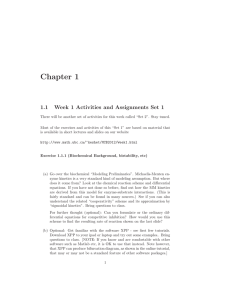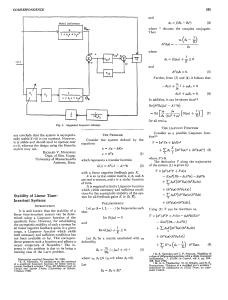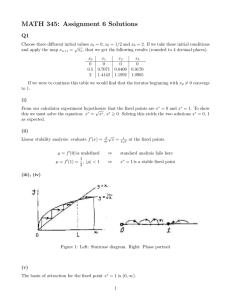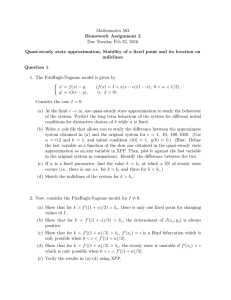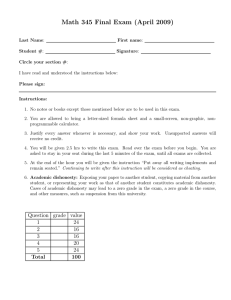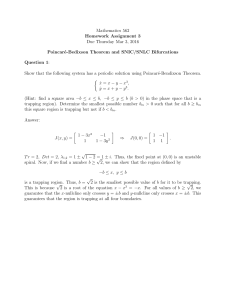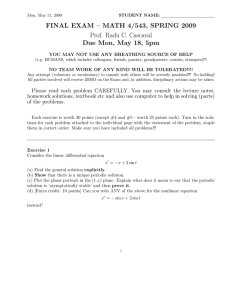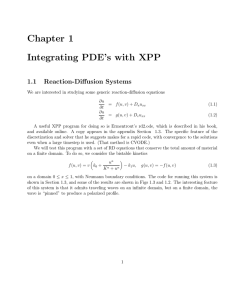Mathematics 345 Homework Assignment 6 Due Tuesday March 22, 2016
advertisement
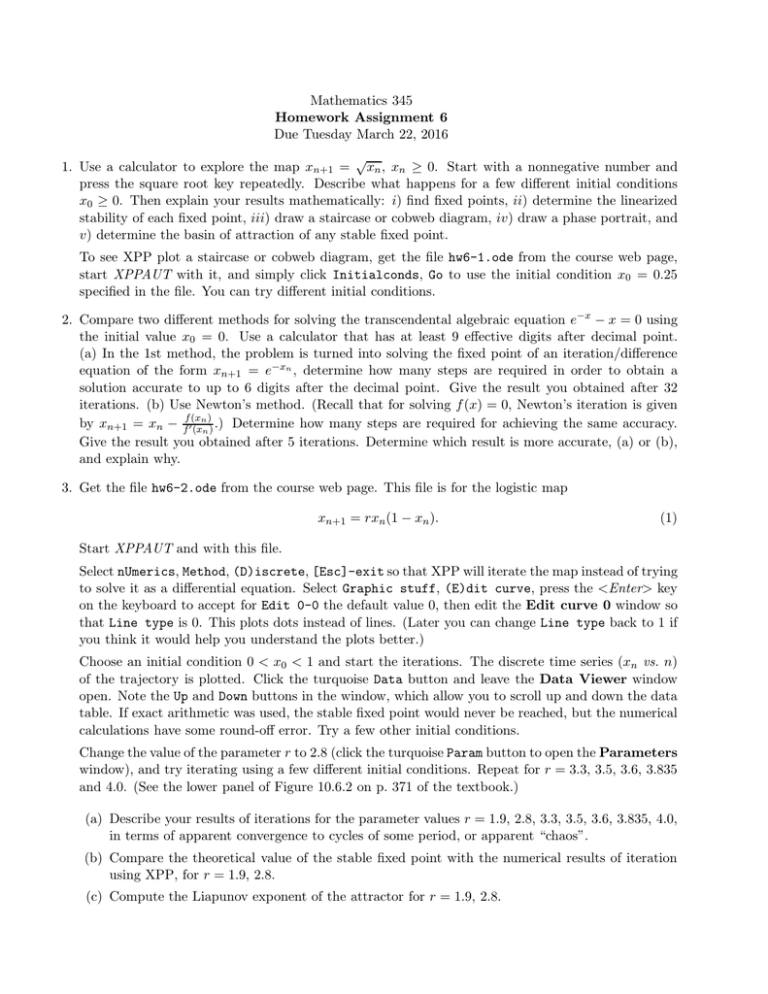
Mathematics 345 Homework Assignment 6 Due Tuesday March 22, 2016 √ 1. Use a calculator to explore the map xn+1 = xn , xn ≥ 0. Start with a nonnegative number and press the square root key repeatedly. Describe what happens for a few different initial conditions x0 ≥ 0. Then explain your results mathematically: i) find fixed points, ii) determine the linearized stability of each fixed point, iii) draw a staircase or cobweb diagram, iv) draw a phase portrait, and v) determine the basin of attraction of any stable fixed point. To see XPP plot a staircase or cobweb diagram, get the file hw6-1.ode from the course web page, start XPPAUT with it, and simply click Initialconds, Go to use the initial condition x0 = 0.25 specified in the file. You can try different initial conditions. 2. Compare two different methods for solving the transcendental algebraic equation e−x − x = 0 using the initial value x0 = 0. Use a calculator that has at least 9 effective digits after decimal point. (a) In the 1st method, the problem is turned into solving the fixed point of an iteration/difference equation of the form xn+1 = e−xn , determine how many steps are required in order to obtain a solution accurate to up to 6 digits after the decimal point. Give the result you obtained after 32 iterations. (b) Use Newton’s method. (Recall that for solving f (x) = 0, Newton’s iteration is given n) by xn+1 = xn − ff′(x (xn ) .) Determine how many steps are required for achieving the same accuracy. Give the result you obtained after 5 iterations. Determine which result is more accurate, (a) or (b), and explain why. 3. Get the file hw6-2.ode from the course web page. This file is for the logistic map xn+1 = rxn (1 − xn ). (1) Start XPPAUT and with this file. Select nUmerics, Method, (D)iscrete, [Esc]-exit so that XPP will iterate the map instead of trying to solve it as a differential equation. Select Graphic stuff, (E)dit curve, press the <Enter> key on the keyboard to accept for Edit 0-0 the default value 0, then edit the Edit curve 0 window so that Line type is 0. This plots dots instead of lines. (Later you can change Line type back to 1 if you think it would help you understand the plots better.) Choose an initial condition 0 < x0 < 1 and start the iterations. The discrete time series (xn vs. n) of the trajectory is plotted. Click the turquoise Data button and leave the Data Viewer window open. Note the Up and Down buttons in the window, which allow you to scroll up and down the data table. If exact arithmetic was used, the stable fixed point would never be reached, but the numerical calculations have some round-off error. Try a few other initial conditions. Change the value of the parameter r to 2.8 (click the turquoise Param button to open the Parameters window), and try iterating using a few different initial conditions. Repeat for r = 3.3, 3.5, 3.6, 3.835 and 4.0. (See the lower panel of Figure 10.6.2 on p. 371 of the textbook.) (a) Describe your results of iterations for the parameter values r = 1.9, 2.8, 3.3, 3.5, 3.6, 3.835, 4.0, in terms of apparent convergence to cycles of some period, or apparent “chaos”. (b) Compare the theoretical value of the stable fixed point with the numerical results of iteration using XPP, for r = 1.9, 2.8. (c) Compute the Liapunov exponent of the attractor for r = 1.9, 2.8. (d) Get XPP to compute the Liapunov exponent: select Initialconds and enter an initial condition on the attractor. Then for this computed orbit, select nUmerics, stocHast, Liapunov and in the command line 0 in response to the question Range over parameters?(0/1). Compare XPP’s values of the Liapunov exponent to the exact values for r = 1.9, 2.8. (e) Compare the theoretical values of the period-2 cycle with numerical results of iteration using XPP for r = 3.3. Also compute the Liapunov exponent of the attractor using XPP, and compare with the exact value for r = 3.3. (f) Find the value of r at which the logistic map has a superstable fixed point. Numerically compare convergence to the superstable fixed point with convergence to a stable fixed point at r = 1.9. (Optional: If you know how to use Maple, try investigating convergence using Digits := 20 or even higher numerical precision. XPP uses relatively low precision arithmetic.) (g) When r = 4, it can be shown that the Liapunov exponent is ln 2 > 0, for a “typical” initial value x0 , so there is sensitive dependence on initial conditions. What is the Liapunov exponent if x0 = 0? What initial values x0 are not “typical”? Use XPP to compute the Liapunov exponents for three initial values that you think are “typical”, and compare the computed Liapunov exponents with ln 2 ≈ 0.693. 4. Consider the cubic map xn+1 = f (xn ) = rxn − x3n for the parameter r in R. (a) Find all the fixed points and determine for which values of r do they exist. (b) Determine the stability of the fixed points found in (a) as a function of r. (c) Find all the period-2 cycles. (Hint: Suppose f (p) = q and f (q) = p. Show that p, q are roots of the equation x(x2 − r + 1)(x2 − r − 1)(x4 − rx2 + 1) = 0.) (d) Determine the stability of the period-2 cycles as a function of r. (e) Hand sketch a partial bifurcation diagram, based on the information obtained for −2 ≤ r ≤ 3. (f) Use the file hw6-3.ode to generate a full scaled bifurcation diagram for this model for parameter values within the interval [−1, 3]. (Run “Initialconds” and then choose “Range”, be patient, the computation may be slow if your computer is not fast enough.) Note that you need to change the initial value x0 from 0.05 to -0.05 to generate the negative valued branch. Print a copy of the digram (note that you can only save half of the diagram which is ok). (g) Change the parameter rmin to 2 and select “Viewaxes”, to change xmin from -1 to 2. Repeat (f) to generate the new full bifurcation diagram. Print a copy of the digram. (Again, you can only save half of the diagram). (h) Now, change the parameters to rmin = 2.835, rmax = 2.845 and select “Viewaxes”, to change xmin = 2.835, xmax = 2.845. Also, change ymin = 0.55 and ymax = 0.62. Repeat (f) to generate the new full bifurcation diagram. Print a copy of the digram. (i) Finally, what happens if (f) is repeated by using the initial conditions x0 = 1.175 and x0 = 3. Use the results in (e) to provide your explanation for what might be wrong (it does not have to be correct. Just try it.) 2
